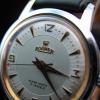Nice 23 Jewel Russian Sekonda Bought From The Bay..
-
Recently Browsing
- No registered users viewing this page.
-
Topics
-
Posts
-
I've been on a ESA 9154 kick lately with this being the latest. A funkalicious 1970's Elgin Electronic with a brown and orange earth toned dial in a big old hunk of steel. Just like the last one this one runs from about -2 to +2 in 5 positions as it seems to be easy to dial these 9154's in.
-
By RichardHarris123 · Posted
I wonder what the theoretical size limit is for both a quartz and mechanical movement? -
By HectorLooi · Posted
I'm currently working on a Citizen 4520 movement. This has to be the smallest and weirdest quartz movement I've ever worked on. Firstly, it's small. Really small. Here's a picture of it next to a LR44 battery for comparison. And unlike conventional quartz movements, the construction of this movement is really weird. The moment I took off the top plate, the rotor and 1st wheel are exposed. The PCB is right on the bottom plate. There are no dial side components and cover plates. Everything goes in from the rear. Not sure if I'm able to fix this watch. The old battery leaked and there are battery juice crystals everywhere. And there is a 1 uA constant leakage current, which will drain the tiny battery in no time. But at least there's still a pulse and the rotor twitches. -
Afraid this is where it could get down to old school adjustment and observation. There are pallet setting tools..but the calibrated ones aren't cheap. The observation holes in the plate will allow you to see if you have one or both stones hanging up/ not engaging on a tooth, That would ofcourse require you to disassemble, heat/move the jewel in/out as required..by eyesight and experience. It's truly trial and error until you get close enough that you could make small adjustments with the banking pins until they drop to the lock freely. You can use a Potence tool to help hold the rok in place during reassmbly. Here's a pic of one...made with a piece of old 18s mainspring You just fold over a roughly 2 inch piece, then file a slot on the end that engages the pallet fork arbor
-









Recommended Posts
Join the conversation
You can post now and register later. If you have an account, sign in now to post with your account.
Note: Your post will require moderator approval before it will be visible.